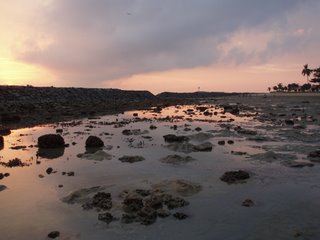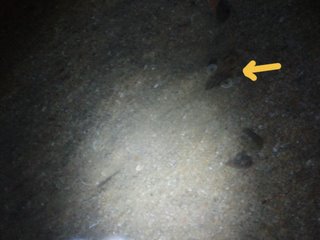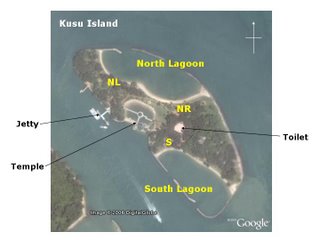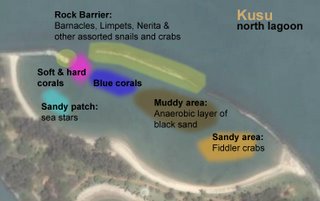kusu reefwalk 29 apr 06
see previous post on kusu reefwalk
this time the weather was great! no rain mud soggy shoes silty waters. was sposed to be on training as a reefwalk guide. but i chickened out and played bystander. the other trainee guides were very very good. they obviously did their homework and answered even inane questions from me confidently. at the end of the session, i was like, i don't want to 'graduate' as a reefwalk guide cos i can't speak as confidently as them and can't tell a moon snail apart from a nerita and i don't want to mislead anyone. another reason is cos i m scared shitless about public speaking.
anyways, was having a really bad sore throat that morning, and stomach was feeling oozy from an overdose of strepsils (which by the way, is a mild laxative). regardless, i was happy to be at kusu on such a great morning with beautiful weather.

the shrimp has great wriggling skills. now you see him...

now you dont....

cos feeling shy from the many kay-poh eyes staring at him, he quickly wriggled into the sand with just his eyes and tail popping out. kawaii ne?
we also saw the anemone shrimp with a pretty tail. like the clown fish, this guy is a good friend of the anemone (at least, he thinks so...). sometimes he can live together with the clown fish in the same anemone. although there may be dominance struggles in the beginning according to a hobbyist website. the anemone provides a shelter for the shrimp, while he contributes by cleaning the anemone. the anemone is a disgusting creature who eats and shits out of the same hole. yea, out of his mouth spews shit. so after he messes himself up, guess who has to clean him up? no marks for right answer. i wonder if mr shrimp eats those stuff or merely removes them. if it is the former, then that makes him equally disgusting and then it makes sense why they are such good friends. anyways, according to reefkeeping, "recent publications (Fautin, et al., 1995; Guo, et al., 1996) have indicated the relationship may be more ectoparasitic than commensal, as at least some – and perhaps all – of these shrimps eat tentacles and tissues from their host."
well, enough shit talk. we also saw several flower crabs that morning. one guy was chomping down another smaller one. wah... seafood breakfast at restoran kusu. i envy him. anyways, do you know why the female crab has a larger, rounded flab compared to male crabs? according to the learned guides, it is so as to carry the egg sac... ohhh.......makes sense. now you know how to choose the crab with higher probability of containing roe when you have a seafood meal.
besides that, the learned guides also shed light on the following stuff found in kusu:
* the Blue coral (Heliopora coerulea) - is hermatypic. has a calcium carbonate skeleton. according to ARKive, "over time the accumulated deposition of calcium carbonate (limestone) by many hermatypic corals can form large limestone structures known as coral reefs." contains zooxanthellae that makes food for the coral polyps by photosynthesis. that's why the blue coral is often found in shallow waters where it can get the sun.
* the Cactus Algae (Halimeda) - look like a cactus and is very important to reefbuilding. grows quickly and produces calcium carbonate. sadly, there aint many of these algae in kusu. maybe an indicator that the amounts of calcium and carbonate are low in the waters here.
* Soft corals - the tentacles of their polyps are always in multiples of 8 (comparison: for hard corals, it is multiples of 6)
* Limpet - is that hard little thing stuck on rocks and looks like a barnacle. difference with barnacle is that it has a conical shell (barnacle has plate-like structure at the top that opens up to allow it to stretch out its feathery legs). it lives throughout the intertidal zone, adhering itself to rocks firmly by its muscular "foot". some species are known to leave their fixed positions sometimes to feed, but always returning to the same spot. apparently, they do this by leaving a mucus trail (just like snails). the shape of the shell grows to follow the contours of the rock so that it is tightly sealed against the rock. this helps prevent the guy from drying out during low tide. it feeds on algae, scraping the algae from the rock with a radula, a ribbon-like tongue with rows of teeth. they are food for some shore birds. you can use the word 'limpet' like this: that annoying person stuck to me like a limpet.
* Fiddler crabs - the males have a huge claw which they wave to attract females to mate. they sometimes fight with other males and if they lost their huge claw in the process, the other small claw will grow larger and the lost claw will regenerate into a small claw. About what they eat, from Wikipedia: "The crab's smaller claw picks up a chunk of sediment and brings it to the mouth, where its contents are sifted through. After anything edible is salvaged, be it algae, microbes, fungus, or other decaying detritus, the sediment is replaced in the form of a little ball. The presence of these sediment balls near the entrance to a burrow is a good indication of its occupation. The action of feeding fiddler crabs is thought to play a vital role in the preservation of wetland environments; by sifting through the sands, they aerate the substrate and prevent anaerobic conditions."
* Black layer under sand - this is the result of the action of anaerobic bacteria, which thrives under low oxygen areas. when the particle size of sand is small the amount of oxygen that can get through is reduced.
here's a map of kusu:

a rough guide to where you can find the different types of marine life. of course, some of them do move around quite a bit...

this time the weather was great! no rain mud soggy shoes silty waters. was sposed to be on training as a reefwalk guide. but i chickened out and played bystander. the other trainee guides were very very good. they obviously did their homework and answered even inane questions from me confidently. at the end of the session, i was like, i don't want to 'graduate' as a reefwalk guide cos i can't speak as confidently as them and can't tell a moon snail apart from a nerita and i don't want to mislead anyone. another reason is cos i m scared shitless about public speaking.
anyways, was having a really bad sore throat that morning, and stomach was feeling oozy from an overdose of strepsils (which by the way, is a mild laxative). regardless, i was happy to be at kusu on such a great morning with beautiful weather.

the shrimp has great wriggling skills. now you see him...

now you dont....

cos feeling shy from the many kay-poh eyes staring at him, he quickly wriggled into the sand with just his eyes and tail popping out. kawaii ne?
we also saw the anemone shrimp with a pretty tail. like the clown fish, this guy is a good friend of the anemone (at least, he thinks so...). sometimes he can live together with the clown fish in the same anemone. although there may be dominance struggles in the beginning according to a hobbyist website. the anemone provides a shelter for the shrimp, while he contributes by cleaning the anemone. the anemone is a disgusting creature who eats and shits out of the same hole. yea, out of his mouth spews shit. so after he messes himself up, guess who has to clean him up? no marks for right answer. i wonder if mr shrimp eats those stuff or merely removes them. if it is the former, then that makes him equally disgusting and then it makes sense why they are such good friends. anyways, according to reefkeeping, "recent publications (Fautin, et al., 1995; Guo, et al., 1996) have indicated the relationship may be more ectoparasitic than commensal, as at least some – and perhaps all – of these shrimps eat tentacles and tissues from their host."
well, enough shit talk. we also saw several flower crabs that morning. one guy was chomping down another smaller one. wah... seafood breakfast at restoran kusu. i envy him. anyways, do you know why the female crab has a larger, rounded flab compared to male crabs? according to the learned guides, it is so as to carry the egg sac... ohhh.......makes sense. now you know how to choose the crab with higher probability of containing roe when you have a seafood meal.
besides that, the learned guides also shed light on the following stuff found in kusu:
* the Blue coral (Heliopora coerulea) - is hermatypic. has a calcium carbonate skeleton. according to ARKive, "over time the accumulated deposition of calcium carbonate (limestone) by many hermatypic corals can form large limestone structures known as coral reefs." contains zooxanthellae that makes food for the coral polyps by photosynthesis. that's why the blue coral is often found in shallow waters where it can get the sun.
* the Cactus Algae (Halimeda) - look like a cactus and is very important to reefbuilding. grows quickly and produces calcium carbonate. sadly, there aint many of these algae in kusu. maybe an indicator that the amounts of calcium and carbonate are low in the waters here.
* Soft corals - the tentacles of their polyps are always in multiples of 8 (comparison: for hard corals, it is multiples of 6)
* Limpet - is that hard little thing stuck on rocks and looks like a barnacle. difference with barnacle is that it has a conical shell (barnacle has plate-like structure at the top that opens up to allow it to stretch out its feathery legs). it lives throughout the intertidal zone, adhering itself to rocks firmly by its muscular "foot". some species are known to leave their fixed positions sometimes to feed, but always returning to the same spot. apparently, they do this by leaving a mucus trail (just like snails). the shape of the shell grows to follow the contours of the rock so that it is tightly sealed against the rock. this helps prevent the guy from drying out during low tide. it feeds on algae, scraping the algae from the rock with a radula, a ribbon-like tongue with rows of teeth. they are food for some shore birds. you can use the word 'limpet' like this: that annoying person stuck to me like a limpet.
* Fiddler crabs - the males have a huge claw which they wave to attract females to mate. they sometimes fight with other males and if they lost their huge claw in the process, the other small claw will grow larger and the lost claw will regenerate into a small claw. About what they eat, from Wikipedia: "The crab's smaller claw picks up a chunk of sediment and brings it to the mouth, where its contents are sifted through. After anything edible is salvaged, be it algae, microbes, fungus, or other decaying detritus, the sediment is replaced in the form of a little ball. The presence of these sediment balls near the entrance to a burrow is a good indication of its occupation. The action of feeding fiddler crabs is thought to play a vital role in the preservation of wetland environments; by sifting through the sands, they aerate the substrate and prevent anaerobic conditions."
* Black layer under sand - this is the result of the action of anaerobic bacteria, which thrives under low oxygen areas. when the particle size of sand is small the amount of oxygen that can get through is reduced.
here's a map of kusu:

a rough guide to where you can find the different types of marine life. of course, some of them do move around quite a bit...


3 Comments:
did u attempt to take a look at your 'laundry baskets'?? i wonder how are they now...
you mean can see from the surface when low tide?? yeah, we shld check them out one day. like have a "Project: Washing the Laundry", clean out the silty stuff and algae from the baskets. you still have map of where they are?
you may be able to see them at spring tides but they should not be. the lab has all the records.
Post a Comment
<< Home